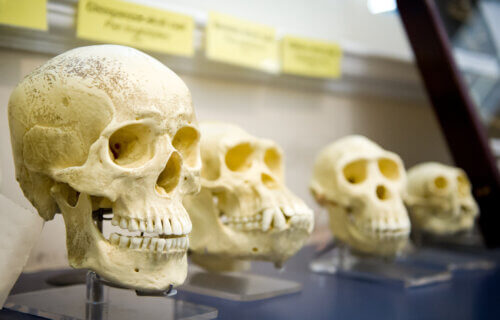PHILADELPHIA — A new study is upending the lineage of human evolution. Researchers from the University of Pennsylvania have discovered that Neanderthals carried human DNA from a much older encounter with a group of now-extinct early modern humans.
Modern humans, also known as Homo sapiens, have long been thought to have migrated to Eurasia around 75,000 years ago, where they encountered and interbred with Neanderthals. Researchers are now suggesting that an ancient lineage of modern humans migrated to Eurasia more than 250,000 years ago, where they also interbred with Neanderthals. Over time, these early modern humans eventually vanished, leaving a population with predominantly Neanderthal ancestry.
“We found this reflection of ancient interbreeding where genes flowed from ancient modern humans into Neanderthals,” says study first author Alexander Platt, a senior research scientist in UPenn’s Perelman School of Medicine, in a university release. “This group of individuals left Africa between 250,000 and 270,000 years ago. They were sort of the cousins to all humans alive today, and they were much more like us than Neanderthals.”
To arrive at this conclusion, researchers compared a Neanderthal genome with a diverse set of genomes from modern indigenous populations in sub-Saharan Africa. This comparison aimed to investigate the presence of Neanderthal-like DNA in sub-Saharan African populations.
“This study highlights the importance of including ethnically and geographically diverse populations in human genetics and genomic studies,” says study senior author Sarah Tishkoff, a Penn Integrates Knowledge University professor.

The study was prompted by the puzzling discovery of Neanderthal-like DNA in several sub-Saharan populations, contrary to expectations that most Neanderthal-human interbreeding occurred in Eurasia, not Africa. To clarify the origins of this DNA, the research team examined genomes from 180 individuals across 12 different populations in Cameroon, Botswana, Tanzania, and Ethiopia.
Their findings revealed that all sub-Saharan populations examined contained Neanderthal-like DNA, with most of it originating from ancient modern humans who interbred with Neanderthals during their migration from Africa to Eurasia over 250,000 years ago. Approximately six percent of the Neanderthal genome was inherited from these early modern humans.
Some sub-Saharan populations also showed evidence of Neanderthal ancestry introduced to them when humans carrying Neanderthal genes returned to Africa. Neanderthal ancestry in these populations ranged from 0 to 1.5 percent, with the highest levels observed in the Amhara from Ethiopia and the Fulani from Cameroon.

To understand the impact of carrying modern human DNA in Neanderthals, researchers investigated the location of these DNA segments within the Neanderthal genome. Their analysis revealed that most of the modern human DNA was found in noncoding regions of the Neanderthal genome, suggesting that having modern human genes in a Neanderthal background was detrimental to fitness. This pattern is reminiscent of what is observed in modern humans, where natural selection has been gradually removing Neanderthal genes.
“So a Neanderthal allele might work great in Neanderthals, but you plop it into a modern human genome and it causes problems. Both modern humans and Neanderthals slowly rid themselves of the alleles of the other group,” explains Platt. “In the almost 500,000 years between the ancestors of Neanderthals splitting off from the ancestors of modern humans and these other modern humans being reintroduced to Neanderthal populations, we had become such different organisms that, although we were still able to interbreed quite readily, the hybrids didn’t work so well, which means we were very far along the path to becoming distinct species.”
This research opens new avenues for exploring human evolution by providing a genetic reference of a population that had been missing from the genomic and fossil record.
“Discovering this ancient lineage of modern humans is really exciting for future research because it gives us a different lens to look at human evolution,” notes study first author Daniel Harris, a postdoctoral research fellow in the Perelman School of Medicine. “Because we don’t have DNA sequences from modern human fossils from that long ago, identifying these sequences will shed light on very early modern human evolution in Africa.”
The study is published in the journal Current Biology.
You might also be interested in:
- Best DNA Test Kits: Top 5 Genetic Services Most Recommended By Experts
- Modern humans still carry some Neanderthal genes, study reveals
- Neanderthals were fine diners? Early humans harvested and roasted tasty crabs, study reveals


I guess they’d just do it with anybody.
It’s the Annunaki blood line. That’s the time they arrived and created humans with their own DNA. its not a shocker!!!